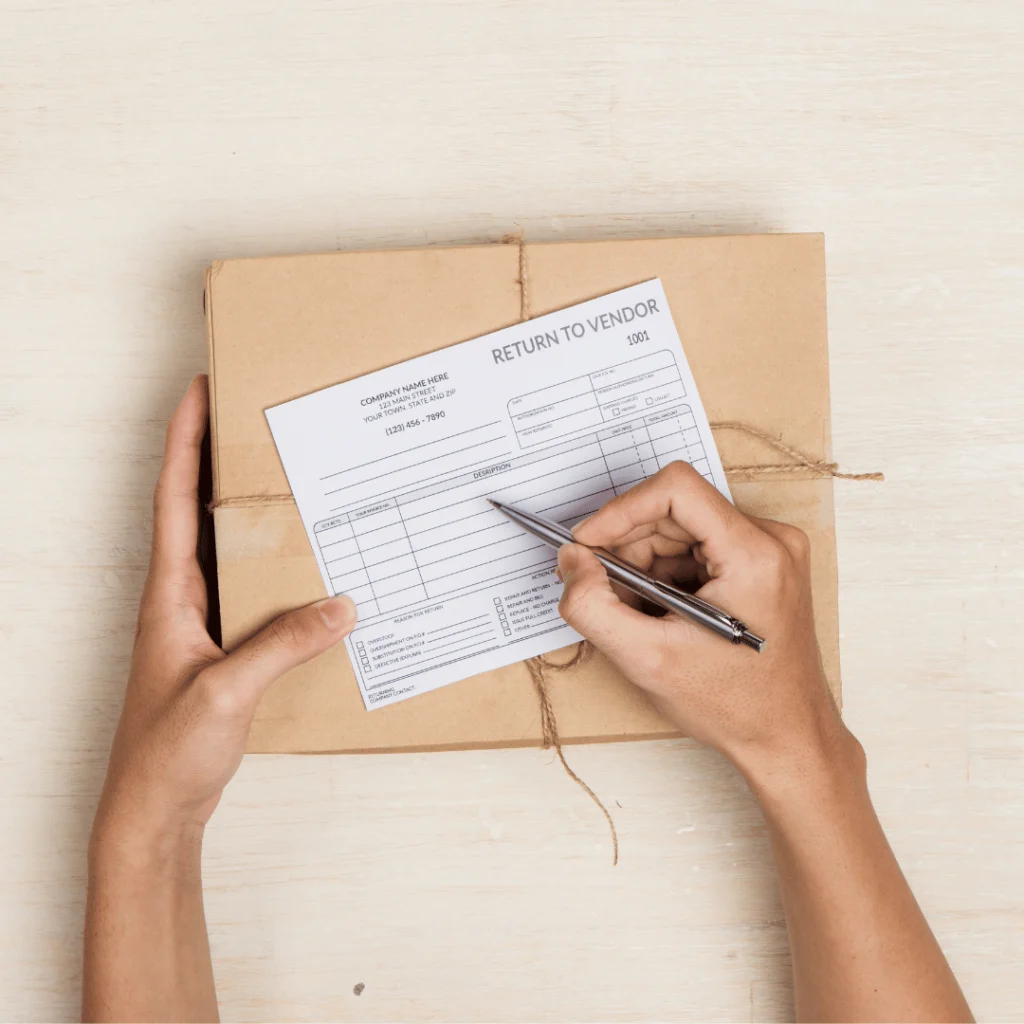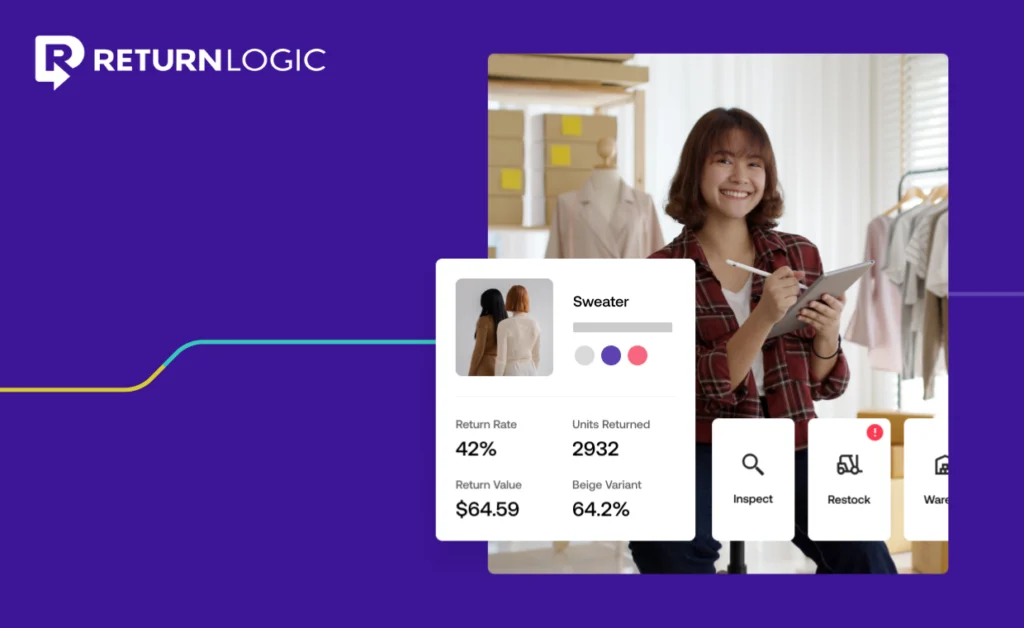

RMA MEANING 101

The world of reverse logistics and ecommerce is fast-paced. Customer satisfaction and efficient order management are essential for your business to succeed. One important aspect of this process is the handling of returns and exchanges.
When selling products to customers, it’s inevitable that ecommerce merchants will encounter returns. That’s where the Return Merchandise Authorization (RMA) comes into play.
The RMA process allows your customers to return products that they are not satisfied with. It is important to understand the meaning and importance of returns management. Its impact on the post-purchase experience is essential to your business.
This guide was created for merchants like you to help define how Return Merchandise Authorizations work, the benefits of automation, RMA best practices, and real examples of merchants who use returns management software to improve their operations and profits.


Return Merchandise Authorization (RMA) is a process and system implemented by ecommerce businesses to manage and facilitate returns and exchanges. It can also be referred to as a Return Authorization (RA) or Return Goods Authorization (RGA). An RMA is an official agreement between a store and its customers that allows the return or exchange of products.
To start, a customer first needs to request an RMA, which is then reviewed and approved by the merchant. A Return Merchandise Authorization (RMA) number is required when exchanging or replacing an item. It may also be issued if a customer is not satisfied with their purchase.
The RMA serves as a reference that allows for tracking and accountability throughout the return or exchange process. It helps customers monitor the progress and status of their return or exchange.
RMAs are important for customer satisfaction. They help merchants provide the service their customers deserve. A RMA system or RMA software ensures that customers and businesses are on the same page regarding return policies and they help prevent fraudulent returns.
In short, the RMA meaning includes a formal procedure that assists businesses in tracking returned items. It also authorizes returns and manages the entire return across the supply chain.
RMA numbers, also known as Return Merchandise Authorization numbers, are unique identifiers assigned to product returns. These numbers allow a merchant to conveniently track the returned products as they make their way back to the warehouse.
Once the returned product reaches the facility, the inventory management software is updated accordingly. Return Authorization Numbers hold even greater significance for stores that offer servicing and repairs for warranty-returned products.
A customer needs to obtain an RMA number from a merchant to return a product. This number is used to track the return. Additionally, the customer needs to provide proof of purchase, such as a receipt, in order to be eligible for an RMA.
Now, let’s dive deeper into the Return Merchandise Authorization process and how it works.

When a customer requests an RMA, a merchant provides them with a Return Authorization Number. This number is then used to identify the return and track it as it moves through the system.
The customer must include this number with the returned item in order for the merchant to process the return. Traditionally, the customer is also responsible for returning the item in the condition it was received, as well as any associated packaging.
Businesses may require customers to provide proof of purchase, such as a receipt, in order to be eligible for an RMA.
The Return Merchandise Authorization process typically involves the following steps:
A customer can initiate a return or exchange request in two ways. Firstly, they can contact the ecommerce store’s customer service department. Secondly, they can use an online request or RMA form.
RMA forms are used to gather important information about the product and the reason for returning it. They provide relevant information such as order number, item details, reason for return, and any supporting documentation like photos.
The RMA form includes important information, such as customer details. It also states the customer’s preference for the item to be returned, refunded, or exchanged. This information is essential for the return process.
After reviewing the return request, the ecommerce merchant evaluates if the product is eligible for a return. This evaluation may include factors such as the item’s condition, adherence to return policies, warranty period, and the reason for return.
A merchant may choose to automate the Return Merchandise Authorization process based on specific return types, return reasons, or shipping rules. This can be done through returns management software.
If the return is approved, the merchant issues an RMA number to the customer. As mentioned above, this number serves as a return authorization and a unique identifier for the return and facilitates tracking throughout the process.

Once the customer has obtained the Return Authorization Number, they need to package the product securely and return it to the merchant. The customer verifies that it is in the same condition as when it was received.
The customer follows the instructions provided by the ecommerce store regarding packaging the item for return. This may involve using the original packaging or specific shipping materials to ensure the item’s safe transportation. The return material authorization number is prominently displayed on the package or label to ensure proper identification by the warehouse team.
The customer must include a copy of the RMA number with the product packaging when sending it back to the merchant. If the customer does not include the RMA number, the merchant may not be able to process the return.
The customer ships the package back to the ecommerce store or warehouse using a designated shipping method and shipping instructions. Merchants using returns management software can choose to enable specific shipping rules based on the return type.
The customer should ensure that the product is packaged securely and includes all original parts and accessories. The merchant may not be responsible for any items that are not returned with the product. This will be outlined in the RMA shipping instructions and shipping policy.
Once the package is dropped off or picked up by a shipping carrier, a shipment tracking number is initiated and sent to the customer. This is usually automated by the shipment carrier (FedEx or UPS) and information is sent to the returns management software.
It is important to monitor the return shipment. It is essential for both parties to track the shipment and keep records of the tracking number for future reference. The customer should also save any tracking information associated with the shipment in case the package is lost in transit.
Once the ecommerce merchant receives the returned product, email communication (via Returns Management Software) is sent to the customer to inform them of the returned item’s arrival.
The next step is for the warehouse and operations team to inspect the returned material thoroughly. This inspection verifies the item’s condition and compliance with return policies.
The warehouse team will communicate with the customer service team on the disposition of the product. Per most return policies, the RMA product quality must be the same as when it was initially shipped.
If the item meets the required product return criteria, the customer service team proceeds with processing the return or exchange. This may involve issuing a refund, offering store credit, or shipping a replacement product in place of a defective product.
Returns management software and warehouse inventory management tools are often used to track the returned product back to stock, liquidated, or damaged.
The ecommerce merchant communicates the resolution of the return to the customer. This could include confirming the refund, providing store credit, or notifying the customer about the shipment of the replacement product. An automated email can be sent and triggered based on the authorization status within the RMA software.
And voila! The Return Merchandise Authorization process is complete. But not so fast…. Are there additional factors a merchant should consider before changing their RMA process? Read on to find out!
A smooth and efficient Return Merchandise Authorization (RMA) process is crucial for any business in the ecommerce industry. It ensures customer satisfaction, streamlines operations, and allows for better management of returns and exchanges.
Let’s explore the key things to consider before updating your RMA process:
Set clear return policies and guidelines
To begin, it’s important to establish clear and comprehensive return policies and guidelines. Your policies should include details such as time limits for returns and acceptable conditions. They should also outline any extra requirements or fees.
By clearly communicating these policies to customers, you can manage their expectations and avoid potential confusion or disputes.
Provide accessible and user-friendly channels:
Offering accessible and user-friendly channels for a customer to submit an RMA is essential for a seamless customer experience. You should consider Implementing several channels for customers to initiate their return requests.
These could include online forms, dedicated email addresses, chatbots, and toll-free phone numbers. Make the process simple and clear. This will allow your customers to provide the necessary information, like order details, reason for return, and preferred resolution.
Train customer service representatives on new procedures:
Well-trained customer service representatives play a crucial role in handling return requests effectively. Train your representatives on these procedures. Teach them how to handle different types of returns and how to explain your return policies to customers.
Assist with the necessary documentation. This will empower your representatives to provide accurate and consistent support to customers throughout the entire returns process.
Integrate Returns Management Software or systems:
Leveraging returns management software or systems can significantly enhance the efficiency and accuracy of your RMA process. These tools automate various aspects of the process, such as generating Return Authorization numbers, tracking return shipments, and managing inventory updates.
Integration with your ecommerce platform can make the process more efficient. It can synchronize order and customer data, which ensures smooth communication and information flow.
Monitor and evaluate the RMA performance:
Regularly monitoring and evaluating the performance of your returns process is crucial for identifying areas of improvement and measuring customer satisfaction. Track key metrics such as return rates, turnaround times, and customer feedback.
Analyze the data to identify patterns, root causes of returns, and opportunities for process optimization. This information will help you make informed decisions and refine your RMA process to better meet customer needs.
Continue to improve the returns process based on feedback and data analysis:
Actively seek feedback from both customers and internal stakeholders regarding their experience with the returns process. Pay attention to customer complaints or suggestions and use them to drive improvements.
Additionally, leverage data to identify trends, recurring issues, or bottlenecks in the full post-purchase process. Implement necessary changes and updates to continuously enhance the efficiency and effectiveness of your returns process.
It’s important to consider these factors to optimize your returns operations. Your RMA process will continually evolve. This will ensure a seamless experience for your customers.
A Returns Merchandise Authorization process, when done right, leads to customer satisfaction. This process also helps to improve business performance and growth.

Implementing an RMA system offers several benefits to ecommerce businesses, including:
Streamlined Returns: RMAs provide a structured process that simplifies the handling of returns and exchanges. It ensures that returns are properly authorized, tracked, and processed, leading to improved operations efficiency.
Fraud Prevention: By requiring a return authorization number, your business can mitigate the risk of fraudulent returns. The authorization process helps verify if the product is eligible for a return request. It prevents returns fraud and abuse of return policies or RMA policies.
Enhanced Customer Experience: A well-executed returns process contributes to a positive customer experience. By providing clear guidelines and policies, easy communication channels, and timely resolutions, your business can build trust and loyalty with customers. This ultimately increases customer lifetime value (CLV)
Improved Inventory Management: A structured and integrated process can help you accurately track returns and exchanges. This will enable you to adjust your inventory levels accordingly.
This ensures that customers have the products they need when they need them. Additionally, you can quickly identify any product issues and take proactive steps to address them.
When inventory management software is integrated with returns software, returned product visibility improves. Shoppers’ expectations are met with an accurate look at what products are in-stock, and merchants are more efficient with real-time inventory and COGS reporting.
Increased Visibility and Reporting: A returns management system generates detailed reports, giving your business a clear view of your return and exchange activities. This helps you analyze customer behavior and identify any areas of improvement in your returns policies.
Data and Analytics: RMA systems generate valuable data on return reasons, product issues, and customer feedback. Analyzing this data can help your businesses identify trends, address product quality concerns, and make informed decisions to improve customer satisfaction.
Now let’s dive deeper into how merchants can use returns data to improve their supply chain.
Ecommerce merchants can optimize their supply chain by leveraging RMA data and insights. Here’s how:

As you’ve learned throughout this guide, Return Merchandise Authorization (RMA) is a vital process in the ecommerce industry, enabling merchants to effectively manage returns and exchanges. Implementing RMA automation software and following these best practices can improve the return management for your ecommerce business.
To ensure effective RMA management, merchants should follow these best practices:
Embracing RMA processes and automation technologies empowers merchants to meet customer expectations, drive growth, and build stronger relationships with their customers.
Looking for examples of ecommerce brands that have implemented RMA software and found success? Let’s head to the next section and dive in.
At ReturnLogic, we work with merchants to create an efficient and customer-friendly returns process. This helps keep customers happy and reduces the costs associated with returns.
Let’s explore a few case studies that highlight successful implementations of RMA processes in different ecommerce businesses:
Company A, an online electronics merchant, implemented an efficient RMA process to enhance customer satisfaction. The return claim process was revamped.
A user-friendly online portal was provided for customers. They can use it to initiate return requests by entering their order details and reasons for return. This makes RMA processing easy to do. The RMA system automatically generated an RMA number and provided clear instructions on packaging and labeling requirements.
Company A invested in RMA software to streamline the inspection and processing phase. This software enabled their warehouse staff to quickly scan and verify returned items. This automation reduced processing time, removed manual errors, and ensured timely resolutions.
The system generated data on return reasons. This allowed the company to recognize common issues. They could then take proactive measures to improve product quality.
By implementing these improvements, Company A experienced a significant reduction in return processing time and an increase in customer satisfaction. The streamlined RMA process contributed to improved organizational efficiency and strengthened customer loyalty.
Company B, a fashion ecommerce merchant, faced challenges with fraudulent returns that were impacting their bottom line. They decided to implement a robust RMA system to address this issue and ensure a fair and secure return process.
Company B introduced a strict authorization process for returns. Customers were required to provide detailed information about the returned item, including purchase date, order number, and reason for return. Additionally, the company introduced a policy where customers needed to provide supporting evidence, such as photographs, to validate the condition of the product for their return claims.
To further prevent fraudulent returns, Company B integrated its RMA system with data analytics tools. This allowed them to analyze patterns, detect suspicious return behaviors, and identify potential abuse of return policies. The system flagged high-risk return requests for manual review, enabling the company to thoroughly evaluate the validity of those returns.
By implementing these measures, Company B significantly reduced fraudulent returns, protecting its profit margins. The robust RMA system instilled customer confidence, ensuring fair returns and exchanges while maintaining a secure and trustworthy shopping environment.
Company C, a home goods ecommerce merchant, recognized the value of RMA data for identifying product quality issues and driving improvements. They implemented ReturnLogic’s returns management software and a robust RMA process. This process not only handled returns but also provided a feedback mechanism for their product development team.
Whenever customers start a return, Company C encouraged them to provide detailed feedback on the reason for the return. The company categorized this feedback and analyzed it regularly to identify recurring issues, design flaws, or customer problems and trends. They used this valuable information to refine their product designs, enhance quality control measures, and identify areas for improvement.
Company C used the data they collected with their RMA processes to create innovative solutions. These solutions increased customer satisfaction, made returns faster, and stopped fraud. This proactive approach helped the company improve its products and identify areas for improvement.
Customers valued the company’s dedication to product improvement. The seamless RMA process offered them the chance to help the company’s ongoing expansion and development.
The company’s commitment to product improvement and customer satisfaction was reflected in the gradual reduction in return rates. This demonstrates the importance of RMA software automation and processes for merchants in the ecommerce industry.
These were just a few examples of merchants and how they leveraged RMA software for improvement. We’ve explained the process, benefits, and best practices, but now let’s dive into an RMA software preview.
Shoppers want convenience and options to choose their own returns journey. Shoppers can use ReturnLogic to easily navigate the Self-Service RMA Center. This includes returns for warranty, store credit, refunds, or exchanges.
The RMA center can be tailored to your brand. It allows you to collect information about why a product is returned. This information is then displayed to your customer service and operations teams for review.
Wondering what return merchandise authorization software looks like? Here are some video examples. These will show you how you can use RMA software to provide your shoppers and team with a tailored RMA experience.
And there you have it! We’ve covered everything you need to know about RMAs in the ecommerce industry.
You’ve learned that Return Merchandise Authorization (RMA) processes are essential for efficient return management in the ecommerce industry. Through successful implementations of RMA systems, merchants can streamline returns, prevent fraud, enhance customer satisfaction, and leverage data for product improvement.
Ecommerce merchants can drive growth and operations efficiency by focusing on the RMA process. Integrating it into your operations creates a seamless and positive experience for your customers.
When RMA processes are implemented correctly, customers can expect a smooth return experience. This encourages customers to trust your business and continue engaging with your brand.
Additionally, merchants can use the data gathered from RMA processes to better understand their customers’ needs and preferences. This allows you to create better products and services that will further build brand loyalty and trust.
Merchants can use the data to identify areas of improvement and develop strategies to mitigate future issues. In the long run, this will lead to increased customer satisfaction, which will contribute to the success of your business.
Have a specific question about RMAs or RMA software? We can help! Talk to one of our RMA experts to learn how you can start automating RMAs today!
See for yourself why 1000+ ecommerce brands trust ReturnLogic to manage their returns.

